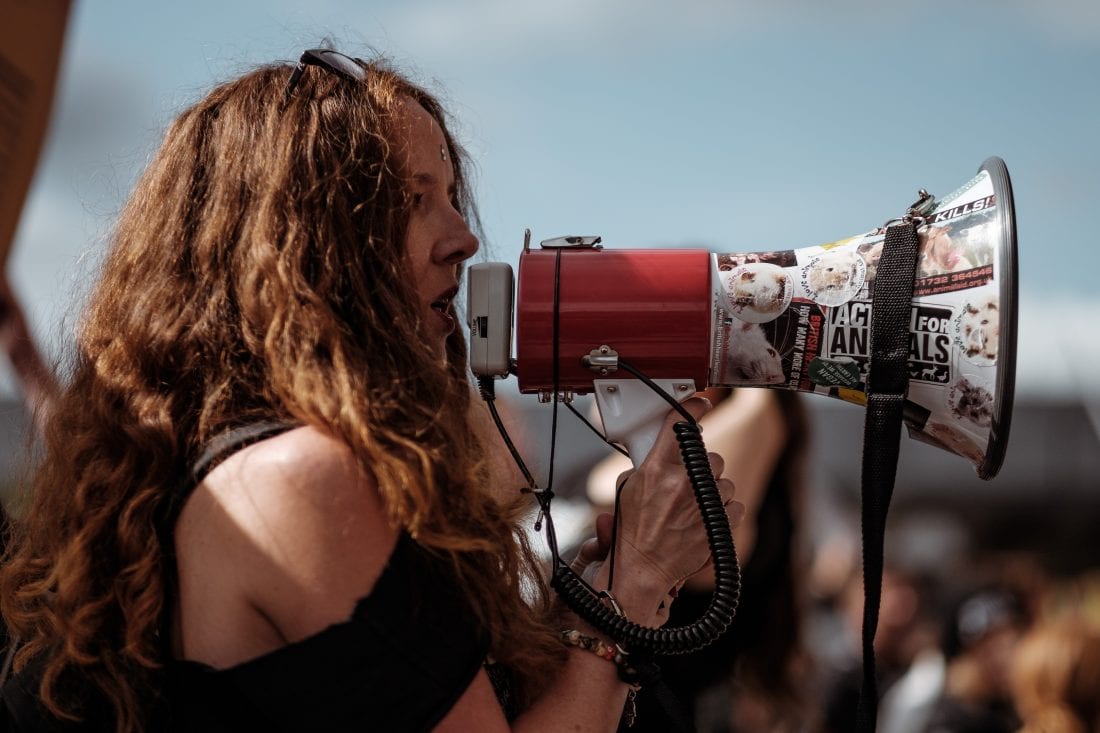
Nonprofit Advocacy 101: 5 Steps to Change the World
Let’s be real: the nonprofit sector is packed with buzzwords, and even insiders aren’t always on the same page about what common terms actually mean. One that is tossed around a lot is “advocacy.”
Broad interpretations of “advocacy” make sense, right? Because all of us are advocating for a better world in some way, whether it’s working to get more children enrolled in early education programs, raising awareness about climate change, fundraising for national parks, or [insert your solution to a social change issue here]. But what does “advocacy” really mean? Here’s my preferred definition:
Advocacy is shifting the balance of power to create social change.
In digital advocacy, one of the services that Media Cause specializes in, this often means mobilizing people online (to build power), then guiding them down a strategic path that activates that collective power to effectively shift the balance of power that is preventing (or reversing) progress on an issue.
When you think of advocacy through this lens, it’s easy to separate tactics from strategy. Here’s a short list of tactics that you’re probably familiar with:
- Online petitions
- Social media posts
- Emails – Did you know that in 2017, advocacy emails had the highest click-through rate (2.5%) of all nonprofit email types? (2018 M+R Benchmarks Report)
- SMS / Text
So, if your nonprofit is already using these tactics, does that mean you’ve already maximized your advocacy efforts? Not exactly. Digital tools can be used to effectively mobilize people and power, but only when grounded in a well-crafted strategy. Essentially, they are tools in your toolbelt, which won’t help you much if you don’t know how to properly use them– just ask any new homeowner!
If using the “right” tools won’t guarantee success in your advocacy campaign, what else can you do to make a “win” more likely? I’m going to share five critical steps to build a winning advocacy strategy for that issue that keeps you up at night…
1. Identify who holds the power for change
The first step to any successful power-based campaign is to figure out who you need to influence to change their behavior.
HINT: The target who holds the power for change may not be the best target for your campaign. Confused? Check out this powerful example from the Coalition of Immokalee Worker’s (CIW) Campaign for Fair Food.
CIW’s campaign goal is to convince large tomato farms to adopt Fair Food Agreements that provide more humane farm labor standards and fairer farmworker wages. In this case, the farms themselves hold the power to treat and pay their workers better. But how do you run an effective public campaign against a farm that is unknown to everyday people, and only sells to businesses (B2B)?
CIW’s answer: Campaign against the very well known consumer brands (B2C) that buy the majority of produce from these farms. By making this strategic decision about the campaign targets, CIW has successfully created leverage through people-powered campaigning to sign agreements with 14 multi-billion dollar food retailers, including Walmart, McDonald’s, and Chipotle, which then resulted in the tomato farms adopting the improved labor standards. Most importantly, this strategy has successfully redistributed power from the farm owners and their corporate buyers back to the farmworkers who were being exploited.
PRO TIP: The actor who holds the power for change is called the primary target. Actors who hold power over the primary target, and are often the best public campaign target, are called secondary targets.
2. What is your Theory of Change?
The next step to building a solid advocacy strategy is to define the key assumptions that you’re making about how change is likely to occur– essentially, what are you trying to cause, and what will be the expected effect? These are often crafted through “If… then…” statements that help define a macro theory of change to clarify your big picture strategy, as well as cross-checking the logic behind every step to achieve your goal and “win.”
A great example of a Theory of Change is the well-known Kony 2012 campaign by Invisible Children, which launched with one of the first social change videos to go viral and amass over 100 million views. In 21:09 – 22:34 of the launch video, you’re introduced to the campaign’s theory of change: If millions of people learn about what Joseph Kony is doing in Uganda, then the US government will take action to help apprehend him.

3. Build a step-by-step campaign blueprint
The next critical component to a strong campaign strategy is mapping out the campaign’s critical path. This process is best explained through the following interactive workshop.
CRITICAL PATH WORKSHOP:
Give each member of your team post-it notes. Have them write down the ultimate goal of your campaign (e.g. reversing climate change, or capturing Joseph Kony) and then the milestones required to achieve that goal. These milestones can be framed as being “important enough to be front page headlines in the New York Times.” After everyone has written down all of the milestones they can think of, ask them to arrange them in reverse order, starting with the ultimate campaign goal at the end, and putting the milestones in the most logical order going backwards until you get to present time. This will likely spur some interesting debate with your team! It will also help you identify gaps in your logic that you can correct before your invest your organization’s valuable time and resources. It will also help your team focus on the most effective tactics to achieve those all-important campaign milestones.
For an example of a critical path, rewatch 21:09 – 22:34 of the Kony 2012 launch video, this time observing how each step towards the end goal (i.e. capturing Joseph Kony) follows a logical series of milestones. Even if you disagree with the goal (or timing) of the Kony campaign, each step towards that goal was based on logic. Also note that every milestone had its own clear theory of change! They say that once you theory of change, you’ll never go back…
4. Eyeballs, Hearts, and Fingertips
Now that you’ve identified your campaign target, thought through your theory of change, and built a critical path to win, it’s time to figure out how you’re going to capture those all-important eyeballs, hearts, and fingertips. No, we’re not going Freddie Krueger on you… we’re talking about getting your campaign visibility in the crowded media space, pulling at people’s heartstrings so they care, and then guiding their fingertips to take meaningful actions online (or to know where to take their boots offline).
There’s so much potential content that you can create– stories, photos, videos, gifs, interviews… and yes, more is better. But resources and time are often constrained when we’re campaigning at a nonprofit, so there’s a simple formula that you should keep in your head no matter what campaign content you’re creating:
Problem + Solution + Action
- Problem — First, you need to define the problem for your audience in a way that grabs their attention. This can be shocking, thought-provoking, or just plain unexpected. Make it stand out and highlight the depth and urgency of the problem.
- Solution — Next, you need to clearly articulate what the solution is to the problem you’ve described. Supporters are looking to you as an expert to explain effective solutions, not just point out problems.
- Action — Finally, activate your audience through a clear call-to-action. Use that pent up emotion and well-crafted solution to drive meaningful actions to help people be part of the solution for social change.
Here’s an example advocacy email from our client, ACLU of California, that follows this simple formula:
PRO TIP: Want to learn how to activate this formula for your fundraising goals? Don’t miss this blog about how to write great fundraising emails!
5. Build, Activate, Pivot (you’ll probably need to), and Win
Finally, think through all of the online and offline channels that you can use to build a strong community of supporters– the backbone of any successful people-powered campaign. Are you leveraging paid advertising? Eye-catching organic social content? Guerilla marketing stunts that you can amplify online? Remember that in our 2.0 world, press outlets often follow trending content, not vice versa, so focus on what is going to rise above the media noise and the media hits will follow.
And don’t forget the whole point your creativity: building a large, engaged, and motivated supporter base! As social change professionals, we’re not in the business of raising awareness for awareness’ sake– we’re out to change the world. So make sure you’re capturing supporters’ emails, mobile numbers, or other data that will allow you to re-engage and activate them into the future.
Lastly, approach your campaign strategy like a tech entrepreneur. Before your eyes roll too far back in your head, let me explain. As a campaigner, you need to be wedded to the end goal, not the process, in the same way that tech companies care more about how consumers are using their product than the product itself. Did you know that Instagram was actually a more feature-heavy app called Burbn before it became the streamlined social network with over 1 billion users? Similarly, if your advocacy campaign is not catching on with supporters, or not creating enough leverage against your target to influence their behavior, then pivot to a new strategy and pivot fast!
In a world brimming with challenges that need to be solved, there’s no time to waste trying to convince people to support a cause. Keep experimenting and pivoting until your approach catches on, then listen to your supporters, and ride that momentum as far as it will go… until you need to pivot again.
Advocacy wins aren’t easy– it’s a David vs. Goliath world out there– but if you follow these five steps, you’ll get there eventually.
Need help building and executing an advocacy campaign that will shake the world? Give us a shout. We’d love to partner with you to help change the world.